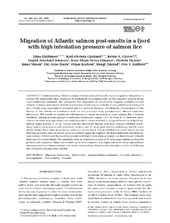| dc.contributor.author | Halttunen, Elina | |
| dc.contributor.author | Gjelland, Karl Øystein | |
| dc.contributor.author | Glover, Kevin | |
| dc.contributor.author | Johnsen, Ingrid Askeland | |
| dc.contributor.author | Serra-Llinares, Rosa-Maria | |
| dc.contributor.author | Skaala, Øystein | |
| dc.contributor.author | Nilsen, Rune | |
| dc.contributor.author | Bjørn, Pål Arne | |
| dc.contributor.author | Karlsen, Ørjan | |
| dc.contributor.author | Finstad, Bengt | |
| dc.contributor.author | Skilbrei, Ove Tommy | |
| dc.date.accessioned | 2018-07-31T09:27:54Z | |
| dc.date.available | 2018-07-31T09:27:54Z | |
| dc.date.issued | 2018 | |
| dc.Published | Halttunen E, Gjelland KO, Glover KA, Johnsen IA, Serra-Llinares, Skaala Ø, Nilsen R, Bjørn Pa, Karlsen ØK, Finstad B, Skilbrei OT. Migration of Atlantic salmon post-smolts in a fjord with high infestation pressure of salmon lice. Marine Ecology Progress Series. 2018;592:243-256 | eng |
| dc.identifier.issn | 0171-8630 | en_US |
| dc.identifier.issn | 1616-1599 | en_US |
| dc.identifier.uri | https://hdl.handle.net/1956/17911 | |
| dc.description.abstract | Understanding Atlantic salmon Salmo salar post-smolt coastal migration behaviour is crucial for predicting their exposure to ecological challenges such as the parasite salmon louse Lepeophtheirus salmonis. We compared the migration of acoustically tagged, hatchery-reared Atlantic salmon post-smolts of wild and domesticated origins from the inner, middle and outer part of a 172 km long aquaculture-intensive fjord in western Norway. Additionally, we examined if the timing of the release or treatment with an anti-parasitic drug (prophylaxis) altered migratory behaviour. We found no significant differences in mean progression rates among the 3 release locations, among genetic groups or between treatments (range: 11.5-16.9 km d-1). However, individual variation in progression rates and migratory routes resulted in large differences in fjord residence times (range: 2-39 d). Ocean-current directions during and after release affected swimming speed, progression rate and route choice, and for most post-smolts, swimming speeds were much higher than their progression rates out of the fjord. The predicted lice loads based on lice intensity growth rates on smolts held in sentinel cages throughout the fjord indicated that individuals taking >10 d to exit the fjord in periods with high infestation pressure are likely to get lethally high sea-lice infestations. We conclude that, as migratory routes of S. salar post-smolts are hard to predict and migration times can stretch up to over a month, it is important to develop aquaculture management that keeps salmon lice levels down along all potential migration routes and during the full potential migratory period. | en_US |
| dc.language.iso | eng | eng |
| dc.publisher | Inter-Research | en_US |
| dc.rights | Attribution CC BY | eng |
| dc.rights.uri | http://creativecommons.org/licenses/by/4.0 | eng |
| dc.subject | Migratory behaviour | eng |
| dc.subject | Salmo Salar | eng |
| dc.subject | Lepeophtheirus salmonis | eng |
| dc.subject | Acoustic telemetry | eng |
| dc.subject | Management | eng |
| dc.subject | Fish farming | eng |
| dc.subject | Parasite | eng |
| dc.title | Migration of Atlantic salmon post-smolts in a fjord with high infestation pressure of salmon lice | en_US |
| dc.type | Peer reviewed | |
| dc.type | Journal article | |
| dc.date.updated | 2018-04-04T17:32:29Z | |
| dc.description.version | publishedVersion | en_US |
| dc.rights.holder | Copyright 2018 The Author(s) | en_US |
| dc.identifier.doi | https://doi.org/10.3354/meps12403 | |
| dc.identifier.cristin | 1577524 | |
| dc.source.journal | Marine Ecology Progress Series | |
| dc.relation.project | Norges forskningsråd: 221404 | |
| dc.subject.nsi | VDP::Matematikk og naturvitenskap: 400::Zoologiske og botaniske fag: 480 | |
| dc.subject.nsi | VDP::Mathematics and natural scienses: 400::Zoology and botany: 480 | |

